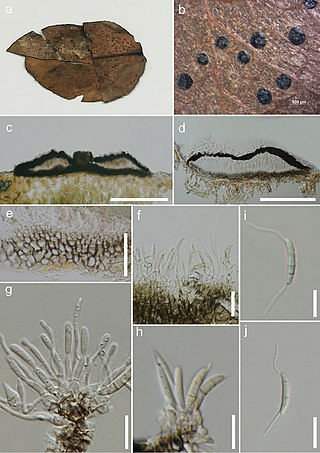
Mycobacterium is a genus of over 190 species in the phylum Actinomycetota, assigned its own family, Mycobacteriaceae. This genus includes pathogens known to cause serious diseases in mammals, including tuberculosis and leprosy in humans. The Greek prefix myco- means 'fungus', alluding to this genus' mold-like colony surfaces. Since this genus has cell walls with a waxy lipid-rich outer layer that contains high concentrations of mycolic acid, acid-fast staining is used to emphasize their resistance to acids, compared to other cell types.

Venturia is a genus of fungi in the family Venturiaceae. First identified in 1882, species in the genus are plant pathogens. Venturia is widespread and the genus contains an estimated 58 species, or 130 species. Anamorphs were historically represented in the genus Fusicladium.
This article summarizes different crops, what common fungal problems they have, and how fungicide should be used in order to mitigate damage and crop loss. This page also covers how specific fungal infections affect crops present in the United States.

Pestalotiopsis is a genus of ascomycete fungi in the Sporocadaceae family.
Diaphanopellis is a genus of rust fungi in the family Coleosporiaceae. Reported as new to science in 2005, the genus is monotypic, containing the single species Diaphanopellis forrestii, found growing on Rhododendron selense subsp. selense, in the Himalayas.

Elias Judah Durand was an American mycologist, and botanist. He was one of the foremost American experts on the discomycetes.
Chrysomyxa cassandrae is a fungus that occurs throughout the North Temperate Zone wherever Chamaedaphne calyculata occurs, independent of host alternation. Aecial hosts include white spruce.

Discosia is a genus of plant pathogens in the family Sporocadaceae.

Neopestalotiopsis is a genus of plant pathogens in the family Sporocadaceae.
Pararamichloridium is a genus of fungi in the monotypic family Pararamichloridiaceae and within the monotypic order of Pararamichloridiales and also in the subclass Hypocreomycetidae. They are saprobic on wood in terrestrial and freshwater habitats.






